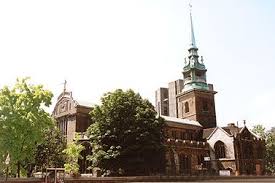Why the history behind All Hallows is so interesting
All Hallows-by-the-Tower is a church near to the Tower of London that dates back to Saxon times, and you can still see the remains there of a 1,000 year old arch!
From the Church of England denomination, ‘All Hallows’ was founded in 675 and previously dedicated to St Mary the Virgin, thus it is an ancient Anglican church – quite possibly the oldest in London.
Originally, the church was a Saxon Abbey called All Hallows Barking that was built on the site of a former Roman building and traces of this have been discovered in the crypt, although much of Hallows has been expanded and it was rebuilt many times back in the Middle Ages.
All Hallows – with its proximity to the Tower of London – inevitably meant the church acquired royal connections hence, Edward IV made the place a royal chantry (which is a trust fund for priests) and many times, executed victims of serious crimes, would be taken to All Hallows before receiving a proper burial.
Oddly enough, the heart of Richard I is said to be buried somewhere in the churchyard of the northern part of All Hallows, where there was a chapel that was built by Richard in the twelfth-century and once stood here.
One reason the church needed rebuilding was down to an explosion in 1650 when the place was being used to store many barrels of gunpowder; 50 nearby houses were completely destroyed and many people were killed.
Hallows only just managed to survive The Great Fire in 1666 largely because Admiral William Penn, got his men to demolish the surrounding buildings and thankfully create firebreaks; Samuel Pepys climbed the church spire at All Hallows to watch the Great Fire spread across London and once again the church needed reconstruction from extensive damage from the Blitz in World War II.
Following the reconstruction after the war, All Hallows was rededicated in 1957, thus some of it survived the war and some the cruel test of time, hence the outer walls are still from the fifteenth-century, and the arch doorway is the original Saxon one for the seventh-century; now the oldest in London!
Many brasses remain in the interior (where one of London’s brass rubbing centres is now located).
Three outstanding wooden statues of saints dating from the fifteenth and sixteenth centuries can also be found in the church, as can an exquisite Baptismal font cover, which was carved in 1682 by Grinling Gibbons for £12, and which is regarded as one of the finest pieces of carving in London.
In 1999 the AOC Archaeology Group excavated the cemetery and made many more significant discoveries, thus the church was designated a Grade I listed building on 4 January 1950 and has a museum called the Crypt Museum, containing portions of a Roman pavement which together with many artifacts was discovered many feet below the flooring in 1926.
The exhibits in the Crypt Museum focus on the history of the church and the City of London, and include Saxon and religious artefacts. Also on display are the church’s registers dating back to the sixteenth-century, and notable entries include the baptism of William Penn, the marriage of John Quincy Adams, and the burial of Archbishop William Laud.
.
Peter Paul Rubens painted Consequences of War around 1638, thus the painting is also known as Horrors of War hence, it was commissioned by the Medici family about the Thirty Years’ War that ravaged seventeenth-century Europe.
Although the commission came from Italy, the painting is in Flemish Baroque style; we see Mars, the mythological God of War (as the central figure) who is seen charging with his shield, while brandishing a sword, in this marvelous picture.
Red is clearly the dominant colour, and superbly emphasizing the presence of Mars in the painting.
On the far left is the Temple of Janus with the door open between two pillars, and this denotes conflict (referencing Fasti, by Ovid) thus, Venus has her arm looped around Mars to try to stop his charge. Venus is exposing rolls of her own flesh in a manner typically depicted by this artist, thus this wonderfully drawn Goddess of Love is accompanied by Amors and Cupids attempting to assist her.
Pestilence and famine are the effects of war and monsters in the painting show this by heightening the terror of the scene. The lute usually means harmony though it is broken probably referring to confusion, and the mother clutching her child means that hostilities corrupt everything including procreation; the fallen architect certainly alludes to the opposite of creation – destruction!
In this wonderful painting, arrows lie on the ground and the olive branch has been cast away signifying the absence of peace; the woman in black further symbolizes how Europe is unfortunately suffering from this fighting, which has led to destruction and famine wiping out a significant portion of the German population.
Peter Paul Rubens was a diplomat as well as an artist, thus he lobbied with considerable passion and cleverness for an end to the Thirty Years War with elements of success; his contribution included carrying messages, demands and concession agreements back and forth between Spain and England – a duty for which he became knighted by Charles I – thus, Rubens clearly showed in this painting that he had a sincere desire for peace.
In Flemish Baroque style, the Consequences of War is a typical painting from Rubens own manual, with elements of the Renaissance influenced by Michelangelo, Titian, Carracci and Caravaggio. For example, Titian’s, Venus of Urbino, surely inspired Rubens as there are similarities that are unmistakable between the two paintings.
The Thirty Years War (1618-1648) was fought in Germany and involved most of Europe; hugely destructive, it began as a religious conflict between Protestants and Catholics turning to a more general war over politics, hence Rubens finished his dramatic version of events long before the end of the battle.

